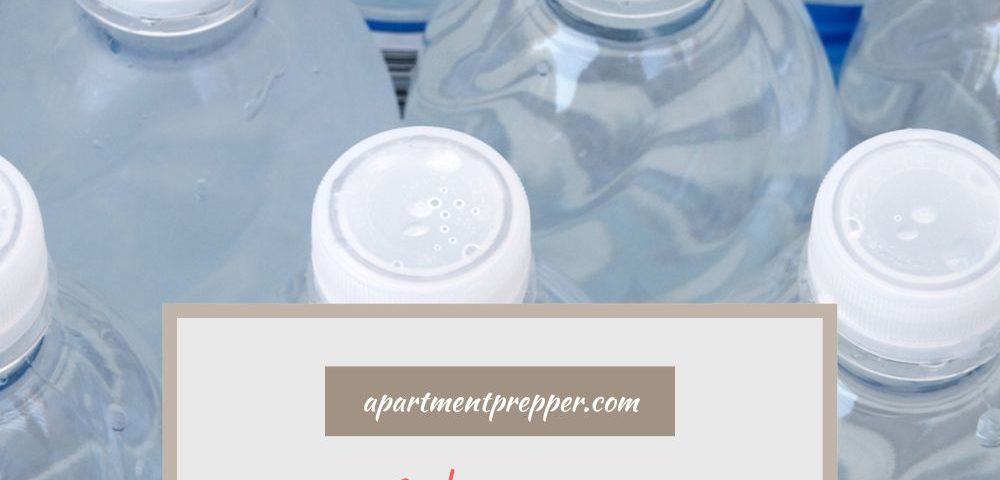Written by Bernie Carr
Storing water for emergencies is one of the most important steps you can take to prepare for an emergency. It is also one of the easiest and inexpensive activities you can do in one day. Let’s look at what you need to do to store water properly.
The bottled water route
If you want to get started right away, pick up bottled water at the store and save them for emergencies. I do have bottled water stored as well. Make sure you store them where they won’t ruin your floor or furniture in case they leak. I have bottle water in a large plastic bin with a lid under a table in the bedroom. They came in handy when I had to replace my Berkey and had to wait a few weeks for a replacement.
I also keep a few in the car but use and replace them on a regular basis.
Does bottled water go bad?
The FDA says bottled water has an indefinite shelf life – it doesn’t really go bad. Check out this article for more details.
How to store water properly for the long term
Pick your container
I recommend food grade, BPA free, heavy duty plastic water containers. Glass would be too heavy and there is always a risk of breakage. Since we are short on space, choose stackable containers. If you prefer recycled containers, avoid re-using containers that have held non-food items as they may contain chemicals that could leach into the water. Used food grade containers that previously contained strong smelling foods such as pickles or garlic may also impart an unpleasant taste or smell to the water, so avoid those as well. I learned a few years ago that those plastic gallon containers you buy at the store can easily spring a leak.
Clean the container
Before storing water, make sure the container is clean and sanitized. Wash it with warm, soapy water, then rinse it thoroughly with clean water. Then, sanitize the container by filling it with a solution of 1 teaspoon of household bleach per gallon of water. Let it sit for at least 30 seconds, then pour it out and rinse the container once again with clean water.
Use clean water
Most municipal systems already purified the water, so it’s safe to drink. Fill your containers with clean tap water. If you’re unsure about the quality of the water in your area, consider a purification method such as water treatment tablets or water filter to purify it. These tablets can kill bacteria, viruses, and other microorganisms that may be present in the water.
Fill your containers
Fill your containers and seal them tightly. Add a label to each container: “Drinking water” and add the date you filled it. This way, you’ll always remember the last time you stored water.
How much water should you store?
The rule of thumb is one gallon per person per day, to cover drinking, cooking, and hygiene needs. You’re limited by the amount of space you have so aim for at least a week’s worth of water for your family.
Where should you store your water?
Store the water in a cool, dark place: Water stored in direct sunlight can promote the growth of algae and bacteria. Store your water supply in a cool, dark place, away from direct sunlight. Avoid storing water near noxious and odorous chemicals or fuel such as gasoline. Fumes can leach into your water storage and contaminate it.
Remember that water is heavy. Many apartments have weight restrictions in certain areas like balconies. If you are going to store a large amount of water (some people use barrels and other large containers), avoid storing it in a balcony or other places that can potentially crack and become a danger to you and others.
Rotate your water supply
Use up the water and refill your containers at least once a year. You can use it for drinking, watering plants, cleaning, washing dishes etc. to avoid wasting water.
Bonus Tip:
If an emergency lasts for several days, there is a chance you will run out of stored water. If tap water becomes unsafe to drink you need a way to purify water. Always have a water filter or purifier as a backup.
A lot of people complain that stored water may taste different. I run all my water through my Berkey water filter and it improves the taste. If you prefer, you can also use a drink mix such as Kool-Aid or Mio to add to your water when you drink it.
If you found this article interesting or helpful, please consider helping us out (without costing you anything)! We are an affiliate of Amazon.com, which means we received a small commission if you click through one of our Amazon links when you shop, at totally no cost to you. This helps keep the lights on at the blog. Thanks!
About the author
Bernie Carr is the founder of Apartment Prepper. She has written several books including the best-selling Prepper’s Pocket Guide, Jake and Miller’s Big Adventure, The Penny-Pinching Prepper and How to Prepare for Most Emergencies on a $50 a Month Budget. Bernie’s latest e-book, FRUGAL DIY has just been released on Amazon. Her work appears in sites such as the Allstate Blog and Clark.com, as well as print magazines such as Backwoods Survival Guide and Prepper Survival Guide. She has been featured in national publications such as Fox Business and Popular Mechanics. Learn more about Bernie here.
FB: https://www.facebook.com/apartmentprepper
Instagram: https://www.instagram.com/apartmentpreppers/
Twitter: https://twitter.com/AptPrepper
YouTube: https://www.youtube.com/channel/UC7vOtdbo-wiBeBxD6puCr1Q
Pinterest: https://www.pinterest.com/aptprepper/


